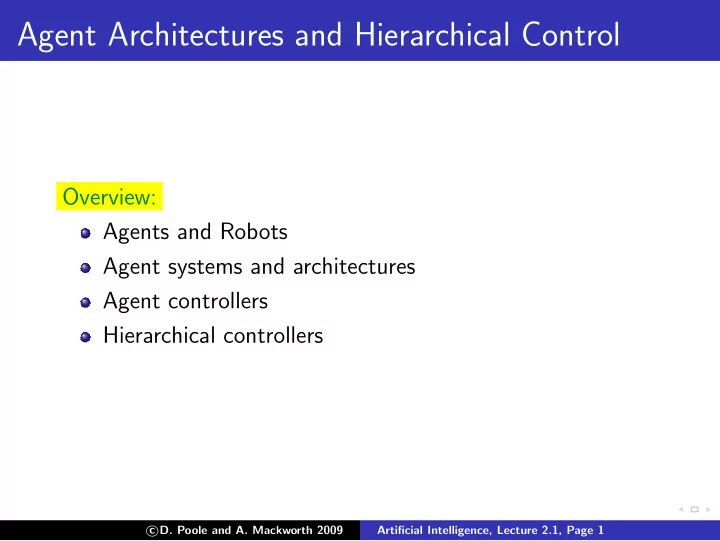

Agent Architectures and Hierarchical Control Overview: Agents and Robots Agent systems and architectures Agent controllers Hierarchical controllers � D. Poole and A. Mackworth 2009 c Artificial Intelligence, Lecture 2.1, Page 1
Agents and Robots A situated agent perceives, reasons, and acts in time in an environment. An agent is something that acts in the world. A purposive agent prefers some states of the world to other states, and acts to try to achieve worlds they prefer. Agents interact with the environment with a body . An embodied agent has a physical body. A robot is an artificial purposive embodied agent. � D. Poole and A. Mackworth 2009 c Artificial Intelligence, Lecture 2.1, Page 2
What makes an agent? Agents can have sensors and effectors to interact with the environment. Agents have (limited) memory and (limited) computational capabilities. Agents reason and act in time. � D. Poole and A. Mackworth 2009 c Artificial Intelligence, Lecture 2.1, Page 3
Agent Systems ROBOT CONTROLLER A agent system is made commands percepts up of a agent and an environment. BODY An agent receives stimuli from the stimuli actions environment An agent carries out ENVIRONMENT actions in the environment. � D. Poole and A. Mackworth 2009 c Artificial Intelligence, Lecture 2.1, Page 4
Agent System Architecture An agent interacts with An agent is made up of a the environment through its body. body and a controller . The body is made up of: sensors that interpret ROBOT ◮ stimuli CONTROLLER actuators that carry ◮ commands percepts out actions BODY The controller receives percepts from the body. actions The controller sends stimuli commands to the body. ENVIRONMENT The body can also have reactions that are not controlled. � D. Poole and A. Mackworth 2009 c Artificial Intelligence, Lecture 2.1, Page 5
Implementing a controller A controller is the brains of the agent. Agents are situated in time, they receive sensory data in time, and do actions in time. The controller specifies the command at every time. The command at any time can depend on the current and previous percepts. � D. Poole and A. Mackworth 2009 c Artificial Intelligence, Lecture 2.1, Page 6
The Agent Functions Let T be the set of time points. A percept trace is a function from T into P , where P is the set of all possible percepts. A command trace is a function from T into C , where C is the set of all commands. A transduction is a function from percept traces into command traces. A transduction is causal if the command trace up to time t depends only on percepts up to t . A controller is an implementation of a causal transduction. � D. Poole and A. Mackworth 2009 c Artificial Intelligence, Lecture 2.1, Page 7
Belief States A causal transduction specifies a function from an agent’s history at time t into its action at time t . An agent doesn’t have access to its entire history. It only has access to what it has remembered. The internal state or belief state of an agent at time t encodes all of the agent’s history that it has access to. The belief state of an agent encapsulates the information about its past that it can use for current and future actions. � D. Poole and A. Mackworth 2009 c Artificial Intelligence, Lecture 2.1, Page 8
Functions implemented in a controller For discrete time, a controller implements: a belief state transition function remember : S × P → S , where S is the set of belief states and P is the set of possible percepts. s t +1 = remember ( s t , p t ) means that s t +1 is the belief state following belief state s t when p t is observed. A command function do : S × P → C , where S is the set of belief states, P is the set of possible percepts, and C is the set of possible commands. c t = do ( s t , p t ) means that the controller issues command c t when the belief state is s t and p t is observed. � D. Poole and A. Mackworth 2009 c Artificial Intelligence, Lecture 2.1, Page 9
Recommend
More recommend